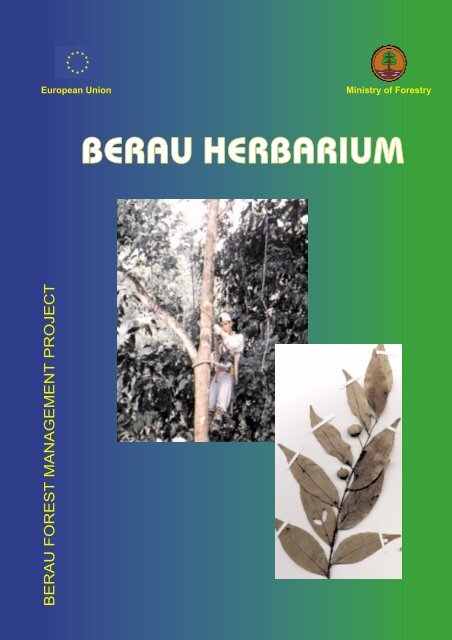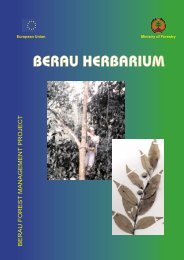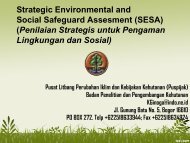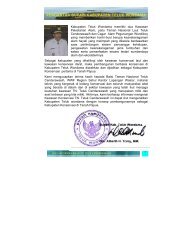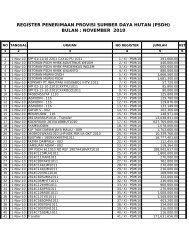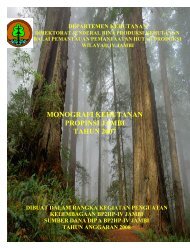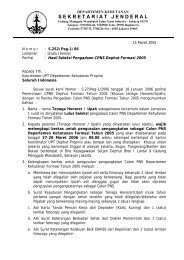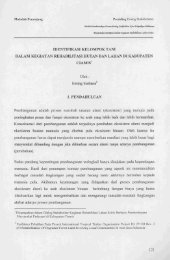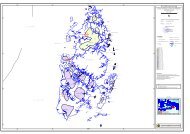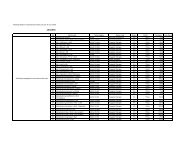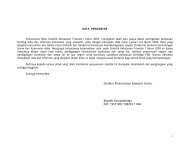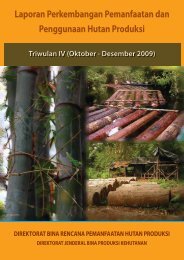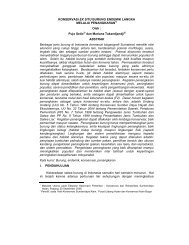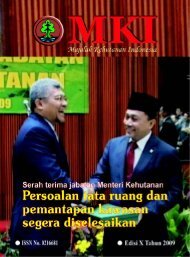BERAU HERBARIUM
BERAU HERBARIUM
BERAU HERBARIUM
You also want an ePaper? Increase the reach of your titles
YUMPU automatically turns print PDFs into web optimized ePapers that Google loves.
European Union<br />
Ministry of Forestry<br />
<strong>BERAU</strong> <strong>HERBARIUM</strong>
<strong>BERAU</strong> <strong>HERBARIUM</strong><br />
Dr. Paul J.A. Keβler<br />
Dr. Gerald Rathert<br />
Berau Forest Management Project<br />
PT Inhutani I<br />
Jakarta 2001
Berau Forest Management Project (BFMP)<br />
Manggala Wanabakti Building Block IV 7 th Floor, Room 707 – 709 A<br />
Jl. Jend. Gatot Subroto, Jakarta 10270, Indonesia<br />
Telepon : (62) (021) 572 0204, 570 4508, 570 3246/65 Ministry Ext. 5399<br />
Tel. / Fax : (62) (021) 572 0205<br />
E-mail : bfmp@cbn.net.id<br />
Http : //www.bfmp.or.id<br />
All rights reserved. This book is protected by copyright.<br />
No part of the text may be reproduced, stored in a retrieval system,<br />
or transmitted, in any form or by any means, electronic, mechanical,<br />
photocopying, recording, or otherwise without written permission from the<br />
copyright holder.<br />
Copyright: Berau Forest Management Project<br />
First published 2001<br />
ISBN number:<br />
Perpustakaan Nasional: katalog dalam terbitan (KDT)<br />
(National Library: catalog in publication)<br />
European Union<br />
Ministry of Forestry<br />
PT Inhutani I<br />
i
PREFACE<br />
There are probably 10,000 – 20,000 plant species in Kalimantan. The flora is rich in<br />
diversity and economically essential, yet has not been fully explored. New species are<br />
continually being found. New initiatives are needed to promote more exploration, and to<br />
use this information for practical needs like sustainable forest management and protection<br />
of Indonesia’s rich biodiversity heritage.<br />
Collecting plant data requires collection and cataloguing of plant specimens in a herbarium<br />
– a botanical “library”. Indonesia’s national herbarium is in Bogor. East Kalimantan has a<br />
regional tree herbarium in Wanariset, Samboja.<br />
The Berau Forest Management Project (BFMP) identified a need to develop herbarium<br />
facilities for Berau to better understand its working environment, and to enhance available<br />
resources for research and education. Berau’s forest is assumed to be biologically rich, yet<br />
because there has been so little botanical collection in this part of East Kalimantan there is a<br />
lack of information and references about what trees really are present. Direct benefits<br />
include a better understanding of forest that will foster ever more appropriate sustainable<br />
forest management techniques.<br />
The Berau herbarium has now reached an international standard and offers an excellent<br />
opportunity to national and international scientists, students and laymen to learn more about<br />
the plant diversity of East Kalimantan. An advantage of the Berau location is that dry<br />
herbarium material can be studied with full access to the tropical lowland forest within less<br />
than two hours drive. It is also part of a commercial concession with practical forest<br />
operators managing the resource. This makes it an ideal base for many activities like tree<br />
recognition courses to support sustainable forest management, marketing studies, and also<br />
for ecological and taxonomic studies.<br />
Jakarta, October 2001<br />
Graham Tyrie<br />
Team Leader and<br />
Co-Director BFMP<br />
Muhandis Natadiwirya<br />
Co-Director BFMP and<br />
President Director PT Inhutani I<br />
ii
CONTENTS<br />
PREFACE.........................................................................................................................ii<br />
CONTENTS...................................................................................................................... 1<br />
ABBREVIATIONS.......................................................................................................... V<br />
INTRODUCTION ............................................................................................................ 1<br />
BACKGROUND............................................................................................................... 1<br />
PURPOSE .........................................................................................................................2<br />
<strong>BERAU</strong> TREE DIVERSITY............................................................................................ 3<br />
LOCATION AND FACILITIES...................................................................................... 5<br />
ORGANISATION AND MANAGEMENT ..................................................................... 6<br />
PLANT MATERIAL COLLECTION AND PREPARATION ...................................... 6<br />
SOME DEFINITIONS........................................................................................................... 6<br />
PRESERVATION OF SPECIMENS.......................................................................................... 9<br />
FUNCTION AND ORGANIZATION OF A <strong>HERBARIUM</strong> ........................................ 11<br />
ESSENTIAL REQUIREMENTS FOR A <strong>HERBARIUM</strong> BUILDING ................................................ 11<br />
DRYING SPECIMENS ....................................................................................................... 11<br />
PROCESSING UNMOUNTED SPECIMENS ............................................................................ 12<br />
MOUNTING SPECIMENS .................................................................................................. 13<br />
IDENTIFICATION OF SPECIMENS ...................................................................................... 13<br />
ARRANGEMENT ............................................................................................................. 14<br />
STRAPPING METHOD ...................................................................................................... 14<br />
DATA PROCESSING .................................................................................................... 17<br />
RAPID DATA ENTRY (RDE) ........................................................................................... 17<br />
DATA EXTRACTION ........................................................................................................ 17<br />
OUTPUT......................................................................................................................... 17<br />
EXPORTING DATA TO OTHER FORMATS ........................................................................... 18<br />
ACHIEVEMENTS OF THE <strong>BERAU</strong> <strong>HERBARIUM</strong> .................................................. 19<br />
iii
TRAINING ..................................................................................................................... 19<br />
FUTURE <strong>HERBARIUM</strong> USE AND EXPANSION....................................................... 20<br />
LITERATURE................................................................................................................ 20<br />
SPECIES IN <strong>BERAU</strong> <strong>HERBARIUM</strong> ............................................................................ 23<br />
iv
ABBREVIATIONS<br />
A/GH Arnold Arboretum and Gray Herbarium, Harvard University,<br />
Cambridge, MA, USA<br />
BFMP Berau Forest Management Project<br />
<strong>BERAU</strong> Berau Herbarium, branch of WAN<br />
BLK Institute for Forestry Training / Balai Latihan Kehutanan<br />
BO Herbarium Bogoriense, Bogor, Indonesia<br />
CIRAD-Forêt Centre de Cooperation Internationale en Recherche Agronomique<br />
pour le Developpment<br />
Dbh diameter at breast height<br />
E Royal Botanical Gardens Edinburgh/UK<br />
FORDA Forest Research and Development Agency / Badan Penelitian dan<br />
Pengembangan Kehutanan<br />
K Royal Botanic Gardens Kew, Kew/UK<br />
L National Herbarium of The Netherlands, Leiden branch, Leiden, The<br />
Netherlands<br />
PSP Permanent sample plots<br />
RKL 5 years concession operational plan / Rencana Karya Lima Tahun<br />
STREK Development of silvicultural techniques for the regeneration of logged<br />
over rain forest in East Kalimantan<br />
TPTI Indonesian Selective Cutting and Planting System / Tebang Pilih dan<br />
Tanam Indonesia<br />
WAN Herbarium Wanariset Samboja/Indonesia<br />
v
INTRODUCTION<br />
Borneo covers about 740000 km 2 and is divided between three countries. To the north lie<br />
Brunei and the Malaysian states of Sabah and Sarawak. To the south lies the largest part of<br />
the island, Kalimantan.<br />
Borneo is one of the most important centres of plant diversity in the world. There are at<br />
least 10000 - 12000 species of flowering plants and somewhere between 40 - 50% are<br />
endemic to the island. Scientific studies of Kalimantan’s flora can be dated back to 1822 in<br />
West Kalimantan, Kutai and the Mahakam River. However, more intensive botanical<br />
studies were conducted in the northern parts of Borneo, supported by the British<br />
administration and private companies. British, Dutch and German scientists dominated the<br />
early 20th century collectors. After 1914, the Northern Borneo Forestry Department started<br />
to set standards for forest management that included systematic botanical investigations.<br />
The fruits of these studies include today’s modern botanical collections in Bogor,<br />
Singapore, Kuching, Sandakan, and more recently in Wanariset, Samboja in East<br />
Kalimantan.<br />
Kalimantan’s flora still needs to be better explored. Of Borneo’s endemic species, about<br />
80% are known from the Malaysian states of Sabah and Sarawak. With more study over on<br />
the Indonesian side of the border, there is little doubt than many more will be discovered.<br />
In a long-term collaboration with various research organisations the Forest Research<br />
Institute Malaysia (FRIM) developed the Tree Flora of Sarawak and Sabah. This is the<br />
most recent coverage of tree species and their taxonomic status occurring in the Malaysian<br />
part of Borneo. There is nothing similar for Kalimantan. Yet national and international<br />
recognition of the economic and conservation value of it forests calls for this gap to be<br />
filled. There is a need for a concise Identification Flora of Borneo. It would underpin efforts<br />
to more accurately attempt to conserve and plan sustainable forest management and use of<br />
this species-rich landscape. This is an immediate and crucial need for more botanical<br />
exploration and collection in Kalimantan, the institutional, scientific and financial resources<br />
to support it.<br />
BACKGROUND<br />
Botanical surveys in Berau started with the STREK Project at the Labanan concession of PT<br />
Inhutani 1, in 1989. The overall goal was to develop silvicultural techniques for<br />
regenerating logged over rain forest as a joint venture between PT Inhutani I, FORDA and<br />
CIRAD-Forêt. Twelve permanent sample plots (PSP) were established in the richest<br />
primary, undisturbed forest of the concession. Six more were placed in logged forest. These<br />
4 ha plots represented the core collection area for tree species collection and study.<br />
All trees with a dbh >10 cm in each PSP were labelled and identified to species where<br />
possible. An average of 493 trees ha -1 , representing a range of 370 - 600 was recorded of<br />
which 65% were identified. Identifications were mainly to species level, using a mixture of<br />
scientific and vernacular names. During 1992 – 1995, a herbarium collection of mainly<br />
1
sterile material was set up. Its 3000 samples included 45 families, 129 genera and 579 taxa.<br />
A database was developed containing the name of each specimen plus some information on<br />
topics like family, local names, species grouping related to commercial use and volume<br />
equations.<br />
In its early phase in 1996 the Berau Forest Management Project (BFMP), within its research<br />
and development programme, identified a need to improve herbarium facilities. A review of<br />
the collection showed that collected material did not meet national or international<br />
herbarium standards in terms of specimen collection, identification, preparation,<br />
conservation and storage. These needed to improved alongside field data and identification,<br />
herbarium management and capacity development of field staff.<br />
Over time and with considerable effort, species identification led to 99% of the tree species<br />
being accurately identified from the STREK PSP. Training and capacity development was<br />
an integral part of this process. Herbarium collections were expanded to cover the entire<br />
Labanan concession, an area of 100000 ha.<br />
These investments in herbarium facilities and management training consolidated the Berau<br />
Herbarium as a functioning institution. It provides a sound applied research that meets<br />
national and international herbarium standards.<br />
PURPOSE<br />
There is no reason to suspect that Berau does not truly represent the rich tree diversity<br />
characteristic of Borneo. Yet because there has been so little botanical collection in this part<br />
of East Kalimantan – only one scientific collection from the late 1960’s is documented –<br />
there is a lack of information and references about what trees really are present. This gap in<br />
knowledge needs to be filled to better understand ecological relationships. In turn, this<br />
understanding will foster ever more appropriate sustainable forest management techniques.<br />
This is especially important because the group of species that are harvested commercially is<br />
going to expand. Forest managers need sound data to ensure that newly harvested forest<br />
resources are extracted sustainably. Furthermore, like many progressive concessions,<br />
Labanan is trying to become FSC and LEI certified. The environmental components of both<br />
systems will require the concession to increase its knowledge of timber species, and use that<br />
knowledge appropriately.<br />
In moving forward, BFMP has built upon the STREK accomplishments to further develop<br />
the herbarium reference collection for Berau, covering the entire Labanan concession. This<br />
will be met, in large part, by training local staff in species identification, herbarium<br />
management and use. These are important steps in building up locally available technical<br />
expertise on tree species, and develop products that meet international botanical standards.<br />
This report has two purposes. The first is to give an overview of the tree diversity in Berau,<br />
focusing particularly on the family Dipterocarpaceae, which is of tremendous commercial<br />
importance as it contains all kapur, keruing and meranti, among others.<br />
2
The second purpose is to introduce Berau Herbarium. It describes techniques for collection<br />
and highlights the facilities available to botanists, foresters and others for improving their<br />
botanical knowledge through self-study and training courses. If the specimens are well<br />
collected and prepared, with accompanying quality data herbaria, Berau Herbarium can join<br />
and share its material with the international community. From there specialists can assist<br />
with difficult identifications and develop longer-term research partnerships. Ultimately, it is<br />
hoped this will inspire interest in further research in northeastern part of Kalimantan.<br />
Dipterocarpaceae<br />
Euphorbiaceae<br />
Verbenaceae<br />
Rubiaceae<br />
Anacardiaceae<br />
Ebenaceae<br />
Bombacaceae<br />
Symplocaceae<br />
Dilleniaceae<br />
Lauraceae<br />
Sapotaceae<br />
Burseraceae<br />
Guttiferae<br />
Annonaceae<br />
Sapindaceae<br />
Caesalpiniaceae<br />
Meliaceae<br />
Myristicaceae<br />
Moraceae<br />
Tiliaceae<br />
Amonaceae<br />
Icacinaceae<br />
Flacourtiaceae<br />
Myrtaceae<br />
Loganiaceae<br />
Magnoliaceae<br />
Celastraceae<br />
Lecythidaceae<br />
Oleaceae<br />
Polygalaceae<br />
Apocynaceae<br />
Mimosaceae<br />
Proteaceae<br />
Fagaceae<br />
Theaceae<br />
Rhizophoraceae<br />
Rutaceae<br />
Hypericaceae<br />
Oxalidaceae<br />
Olacaceae<br />
Rhamnaceae<br />
Myrsinaceae<br />
Ochnaceae<br />
Thymelaeaceae<br />
Figure 1: Relative importance of tree families per<br />
area - mean of 48 ha, all trees dbh > 10 cm<br />
0 5 10 15 20 25<br />
Importance value index<br />
A literature reference lists recent<br />
publications for further study. A<br />
list of the species in <strong>BERAU</strong> (B)<br />
is provided as an annex.<br />
<strong>BERAU</strong> TREE DIVERSITY<br />
The importance of Borneo as a<br />
world centre of plant diversity is<br />
reflected in STREK plot results<br />
from the tropical lowland<br />
rainforest of Berau. There is an<br />
average of 531 trees per ha (dbh<br />
>10 cm) representing 154 species.<br />
With a tree species identification<br />
rate of 99%, mostly to the species<br />
level 55 families have been found<br />
present in 48 ha, 12 plots of 4 ha<br />
each. The most important<br />
commercial family is the<br />
Dipterocarpaceae. The most<br />
important non-commercial family<br />
is the Euphorbiaceae. Their<br />
Importance Value Index (IVI)<br />
scores are 23.4 and 19.4,<br />
respectively. Twenty-five<br />
families with IVI
Dipterocarp genera<br />
Shorea sp<br />
Dipterocarpus sp<br />
Vatica sp<br />
Parashorea sp<br />
Hopea sp<br />
Dryobalanops sp<br />
Anisoptera sp<br />
Cotylelobium sp<br />
Figure 2: Genera abundance of the Dipterocarpaceae - mean of 48 ha<br />
0 1 2 3 4 5 6 7 8 9 10<br />
Accumulative no. of species<br />
600<br />
500<br />
400<br />
300<br />
200<br />
100<br />
0<br />
Importance value index<br />
Figure 3: Species-area curve<br />
1 3 5 7 9 11 13 15 17 19 21 23 25 27 29 31 33 35 37 39 41 43 45 47<br />
ha surveyed<br />
Although the standard deviations are<br />
rather high, indicating high variability<br />
within the sampled plots, the low<br />
standard errors demonstrate they are<br />
representative of overall findings, due<br />
to the high number of replications, n<br />
= 48 (table 1).<br />
Table 1: Species richness<br />
Per ha N Min Max Mean Std.<br />
Error<br />
Std.<br />
Deviation<br />
Total<br />
48 110 198<br />
species<br />
154.65 3.35 23.44<br />
Total<br />
trees<br />
48 417 700 530.75 10.33 71.55<br />
This is also confirmed by the species-area curve. The asymptote is reached with >20 ha of<br />
sampling (figure 3):<br />
4
LOCATION AND FACILITIES<br />
The Berau herbarium is integrated into the BFMP Training Centre in Tanjung Redeb, East<br />
Kalimantan (Latitude 2º 08' N, Longitude 117º 29' E), within the PT. Inhutani I, Adm.<br />
Berau, complex (figure 4). This is less than an hour’s drive from the Labanan concession.<br />
The northern and eastern boundaries of the Labanan research areas are demarcated by<br />
rivers, which provide access by boat. Field camps within the concession provide<br />
accommodation for<br />
Figure 4: Location of Tanjung Redeb with the concession Labanan, PT. Inhutani 1, Adm. Berau<br />
research staff.<br />
The general herbarium<br />
room, in the training<br />
centre (figure 5)<br />
currently contains 168<br />
boxes of herbarium<br />
material, a deep<br />
freezing unit for<br />
material conservation<br />
and various working<br />
and office facilities.<br />
Attached is an external<br />
drying room with a<br />
special electric oven<br />
for gentle drying of<br />
fresh plant material.<br />
Other training centre facilities, such as teaching, presentation and computer capacities, are<br />
made available for herbarium activities, as are field camps (figure 6). The building is fully<br />
air-conditioned.<br />
Figure 5: BFMP Training Centre with integrated Herbarium<br />
Figure 6: Field camp Labanan km 35<br />
5
ORGANISATION AND MANAGEMENT<br />
The Berau Herbarium is as an extension of Herbarium Wanariset in Samboja (WAN),<br />
which is registered in the international catalogue of the herbaria of the world, Index<br />
Herbariorum. For the specimen collection it has its own series code “<strong>BERAU</strong>”. This<br />
follows international herbarium standards and the collection is thus linked to the National<br />
Herbarium of The Netherlands, Leiden branch (L). The Berau Herbarium therefore connects<br />
to other herbaria with significant Asian collections, particularly A, BO, E and K via<br />
Wanariset and Leiden.<br />
PT. Inhutani I and BPK Samarinda jointly manage the herbarium. Two trained staff<br />
members from each organisation are permanently involved and responsible for professional<br />
management activities including material collection, preparation, labelling, storage, file<br />
update and other general operations. BFMP, Wanariset Samboja and the L presently support<br />
them.<br />
Herbarium specimen<br />
PLANT MATERIAL COLLECTION AND PREPARATION<br />
SOME DEFINITIONS<br />
A herbarium specimen is a whole plant or plants, or part of a plant of such a size that when<br />
pressed flat and dried will fit on a sheet of stiff paper or card. The specimens are pressed<br />
flat and dried. The Berau herbarium uses 26 x 42 cm sheets, the same size adopted by BO<br />
and WAN. Specimens are selected to show essential features of branches, leaves, flowers,<br />
and fruits. A number tag relating to a numbered note in a field notebook accompanies each<br />
specimen.<br />
Number tag<br />
A numbered tag connects the specimen to field notes made when the specimen was<br />
collected. Each number is unique, and is prefixed with the herbarium code – in this case,<br />
“B”. Pencil should be used to write on tags, as ink is generally not permanent, washing off<br />
when coming in contact with water, alcohol or sap.<br />
Field notebook<br />
A field notebook records data including:<br />
� The collector and collection number<br />
� Place of collection<br />
� Date of collection<br />
� Features of the plant that will not be available on specimens<br />
6
� Family<br />
� Genus<br />
� Species<br />
� Vernacular name with the name of the dialect or language<br />
� Local uses<br />
� Collector Prefix<br />
� Number<br />
� Location (Country/ Province/ Administrative region/ Town/village<br />
� Longitude and latitude<br />
� Altitude<br />
� Habitat<br />
� Habit – this includes include notes on overall form of the plants, height, diameter,<br />
bark, buttresses, wood, colour of flowers and fruits; essentially those characters that<br />
will be not be available on specimens<br />
Like number tags, pencil should be used for writing in field books, as it will not wash off.<br />
Selecting the specimens<br />
When plants are small and fit to the size of the mounting paper one should dig out the whole<br />
plant and dry the specimens including a portion of the root system. When plants are woody<br />
or too large to make an entire specimen, usually only fertile clippings will be taken. Fertile<br />
clippings are branches with flowers or fruits (preferably both). Generally, at least seven<br />
duplicates are collected. Number tags are attached and the material stored temporarily in<br />
large polythene bags to avoid the specimens drying out before they can be properly<br />
processed.<br />
Large trees should be climbed to reach the fertile branches (figure 7). Safety regulations<br />
must be followed. At minimum, two trained climbers should be involved in the collecting<br />
activities.<br />
7
Numbering of collections<br />
To make record keeping easy, each specimen, or group of duplicates of a specimen, are<br />
given a unique number. The simplest and most recommended method is recording the<br />
Collector’s surname, followed by one or more digits (prefix) and the consecutive number<br />
Figure 7: High tree climbing with harness for collection of fertile<br />
specimens<br />
starting with 1. An example is “Sidiyasa<br />
Berau 1”.<br />
In summary:<br />
� Each collection receives its own<br />
unique number<br />
� Each duplicate of the same<br />
individual gets the same number<br />
� Different individuals of the same<br />
species get a different number<br />
If a numbered specimen is lost, damaged or destroyed, do not re-use its number. It should<br />
be shown as cancelled in the field book as well as in the database. If a mistake is made and<br />
a number duplicated, or two different plants are collected under the same number, separate<br />
the collections by using letters as suffixes to the original number, such as “Sidiyasa Berau<br />
1A”.<br />
Basic equipment<br />
Recommended, basic, equipment for a<br />
plant collector includes the following:<br />
� Rucksack.<br />
� Secateurs<br />
� Pocket knife<br />
� Machete<br />
� GPS<br />
� Altimeter<br />
� Binocular<br />
� Camera and films<br />
� Polythene bags of different sizes, rice sacks<br />
� Jerry can with methylated alcohol (spiritus 80%)<br />
Figure 8: Tree climbing equipment (harness)<br />
8
� Field books, pencils, paper, number tags (tie-on watchmakers tags), newspaper,<br />
plastic string<br />
� Climbing equipment including harness (figure 8), climbing ropes of different length,<br />
shoes with spikes, leather gloves<br />
Figure 9: Preparation of fresh material packing<br />
PRESERVATION OF SPECIMENS<br />
Damaged material is worthless to a herbarium.<br />
Fresh plant specimens will quickly rot or be<br />
damaged by mildew unless preservative treatment is<br />
given. Preservation techniques include drying and<br />
chemical treatments.<br />
Chemical treatment (Wet or Schweinfurth method)<br />
Drying specimens in the field is time consuming and<br />
the result often unpredictable. It is better to preserve<br />
plant specimens in the field using methylated alcohol<br />
(spiritus) at an 80% concentration. Whereas the<br />
disadvantage of wet preservation is that the liquids<br />
are bulky and heavy to carry, the material can be<br />
kept in sealed plastic bags for as long as nine<br />
months. To achieve this the spiritus should not drop below a concentration of 70%.<br />
Each specimen, with its number tag, is<br />
placed between newspaper sheets (figure 9).<br />
Any plant parts sticking out from the<br />
newspaper are clipped to stop them later<br />
puncturing plastic bags (figure 10).<br />
When enough sheets have been accumulated<br />
make a convenient-sized bundle, the bundle<br />
is compressed and tied (figure 11).<br />
Bulky and spiny material is best placed in<br />
the centre of the bundle.<br />
Figure 10: Trimming of plant samples to newspaper size<br />
The bundle is then put into a heavy polythene bag. About half a litre of 80% spirituous is<br />
added per 10 cm of bundle height (figure 12). When full, the open end of the bag is folded<br />
and sealed. The alcohol fills the bags as vapour, and preserves the contents. These bags<br />
should be packed into a suitable strong sack for extra protection. Rice sacks are fine for this.<br />
The final package is very robust and is strong enough to be carried and posted.<br />
9
Figure 11: Tying a bundle of specimens<br />
Figure 12: Adding spiritus for preservation<br />
Back in the herbarium the material will<br />
be dried when convenient.<br />
Drying<br />
Proper drying and chemical treatment<br />
preserves specimens by preventing<br />
bacterial and fungal decay. Removal of<br />
water from the plant tissues still allows<br />
specimen morphological features to be<br />
studied.<br />
Figure 13: Electrical drying stove<br />
Modern drying methods use an electrical drying stove, available at the Training Centre in<br />
Berau. Specimens are dried directly with heated air while a weight flattens them (figure 13).<br />
Depending on the thickness of branches and fruits the process takes about two or three days.<br />
10
FUNCTION AND ORGANIZATION OF A <strong>HERBARIUM</strong><br />
Collecting plant specimens accumulates dried collection. In due course the specimens are<br />
identified and arranged so that specimens of the same species are located together, and that<br />
related species are close to each other. There are various internationally accepted ways to<br />
arrange specimens, as there are of arranging books in a library.<br />
ESSENTIAL REQUIREMENTS FOR A <strong>HERBARIUM</strong> BUILDING<br />
� Location – avoid sites where there is a risk of flooding, spreading fires, or landslides<br />
� Construction – fireproof, with smoke or heat detection alarm system<br />
� A cool, dry atmosphere with humidity as low as possible, 24 hours air condition or<br />
de-humidification<br />
� Adequate work space on benches and tables<br />
� Good ventilation – windows should be screened to avoid access by insects<br />
� Excellent light<br />
� Separate room for drying purposes<br />
� Separate room for preparation and mounting activities<br />
Checklist of materials:<br />
� Newspaper<br />
DRYING SPECIMENS<br />
� Corrugated cardboard, half the size of broadsheet newspapers<br />
� Secateurs<br />
� Tags<br />
� Foam cut into the same size as cardboard<br />
� Electric drying stove<br />
Place the fresh or treated, trimmed and tagged specimens between fresh newspaper sheets.<br />
Make sure that the specimen will show upper and lower surface of leaves when dry. If the<br />
leaves are too large to fit into the folder, they should be folded. In compound leaves one<br />
leaflet of a pair can be trimmed in order to reduce its size for the space available.<br />
11
This newspaper folder is put on corrugated<br />
cardboard (figure 14). In the case of thick and<br />
fleshy fruits or flowers, a piece of foam the<br />
same size as cardboard, with relatively big<br />
holes, should be put on top of the folder. This<br />
keeps the leaves flat and the cardboard level.<br />
The specimen can than be put directly in the<br />
drying stove. This procedure should be repeated<br />
until the drying stove is full. A wooden board<br />
should then be put on top of the pile with a<br />
heavy weight like a stone on top. This will keep<br />
the specimens flat during the drying and<br />
shrinking processes, as the pressure always<br />
remains the same. Temperature should be kept<br />
70°C to avoid overheating and burning of the<br />
paper as well as the material.<br />
All specimens should be dry within 36 – 48<br />
hours, however, after 24 hours material should<br />
be checked for specimens that are already dry<br />
(figure 15). These should be removed. If the<br />
drying process takes too long the material can<br />
become brittle.<br />
PROCESSING UNMOUNTED SPECIMENS<br />
As a rule usually 7 – 9 duplicates of each tree<br />
will be collected. At least one set remains in<br />
Berau, the other duplicates should be sent to the<br />
Wanariset herbarium to be distributed later to<br />
other herbaria (L, BO, BZF, K, A, SAN, etc.).<br />
When sorting duplicates, the following points<br />
should always be considered:<br />
� If the flowers are unisexual, both male<br />
and female flowers should be<br />
represented in each duplicate.<br />
� As far as possible make sure that each<br />
duplicate has a complete range of stages<br />
– flower buds, flowers, young fruits,<br />
mature fruits<br />
� Each duplicate should have a label<br />
attached together with an “Ex HERB”<br />
slip or a cancellation stamp<br />
Figure 14:Layers of foam and cardboard keep leaves flat<br />
during drying<br />
Figure 15: Unpacked, dry fertile specimen with number tag<br />
12
Each duplicate is placed in a double newspaper; if the material is bulky, place a second<br />
newspaper the opposite way round. The duplicates can then be distributed to other herbaria.<br />
Checklist of materials:<br />
� Acid free cartridge paper<br />
� Paper capsules<br />
� Scissors<br />
� Acid free paper straps<br />
� Cardboard supporters<br />
� Accession number stamp<br />
MOUNTING SPECIMENS<br />
When properly prepared and well cared for, mounted herbarium specimens should last<br />
indefinitely. It is therefore very important to select mounting paper, adhesives and inks that<br />
are of archival quality.<br />
The two main aims of the mounting process are:<br />
� To display the specimens and data to allow maximum exposure of features<br />
� To preserve the specimen by securely attaching it to strong mounting paper, but at<br />
the same time allowing for the removal of small portions for more detailed study<br />
Checklist of materials:<br />
� Binocular microscope (50x)<br />
� Lamp<br />
IDENTIFICATION OF SPECIMENS<br />
� Needles, forceps, preparation materials<br />
� Identification materials (Books: Floras, Journals etc; CD)<br />
Before filing, specimens should be checked and the correct identity should be ascertained,<br />
using identification keys in books or CD’s. With the help of the current collection one<br />
should also compare the material with existing material of the same species to further check<br />
if the correct scientific name has been applied.<br />
13
ARRANGEMENT<br />
Choose the best way of presenting the<br />
specimen in order to display all its characters<br />
as far as possible. Labels should be on the<br />
bottom right hand corner, just 0.5 cm from<br />
the lower margin. The consecutive accession<br />
number stamp should be in the top right hand<br />
corner, just 0.5 cm below the upper margin.<br />
Paper capsules should be on the top left hand<br />
corner, just 0.5 cm below the upper margin.<br />
Number tags must be preserved with the<br />
specimens by gluing them to the sheet still attached to the specimen.<br />
STRAPPING METHOD<br />
Small straps of gummed linen (figure 16) or<br />
paper are placed across the specimen at<br />
intervals and stuck to the sheet at either end.<br />
Thin straps should be used on finer portions<br />
of the specimen and thicker straps where extra<br />
strength is needed, like over stems or thick<br />
fruits. Avoid strapping over important details,<br />
such as flowers or small inflorescences, as<br />
well as the nodes on a twig. When strapping is<br />
applied across a leaf-blade, only attach the<br />
ends of the strap where contact is made with<br />
the paper. This allows the leaf to move freely<br />
when the sheet is handled.<br />
Covers<br />
A species cover (figure 18) covers every<br />
sheet. A Genus cover covers groups of<br />
species covers. Genus covers are normally<br />
the more robust and are provided with a<br />
family and genus name in the bottom right<br />
hand corner. Often different colours are used<br />
to indicate geographical areas. For example,<br />
in WAN different colours are used for the<br />
four provinces of Kalimantan and areas<br />
outside Kalimantan. Type material is<br />
protected using red genus covers.<br />
Figure 16: Cutting mounting straps<br />
Figure 17: Mounting specimens on acid free paper, using<br />
straps<br />
Figure 18: Preparing the specimen covers for storage<br />
14
Arrangement of Herbarium Collections<br />
The herbarium is a storehouse of valuable information, like a library. And like a library, it<br />
must be arranged in such a way that information can easily be retrieved.<br />
The Berau herbarium uses an alphabetical arrangement for families as well as for genera<br />
and species. This makes it easy for non-specialists to find specimens, and unskilled<br />
personnel can add mounted material to the herbarium.<br />
Wooden boxes in cupboard pigeonholes are used to store specimens. Filing of specimens<br />
starts at the top left hand corner (A) and moves down that column then moving to the top of<br />
the second column of pigeonholes. The bottom left hand corner therefore contains<br />
specimens starting with Z.<br />
Figure 19: Rack with boxes for permanent storage of herbarium specimens<br />
Pests and treatments<br />
Outside, the contents<br />
are labelled, for<br />
example:<br />
-Annonaceae<br />
-Orophea<br />
-hexandra<br />
The species marking<br />
is the alphabetically<br />
lowest species in the<br />
box.<br />
Long-term preservation of herbarium specimens must involve constant vigilance to protect<br />
them from damage by pests. Under humid tropical conditions insects and fungi pose two<br />
serious threats.<br />
Those insects most commonly found and the most destructive are:<br />
� Herbarium beetles<br />
� Cigarette, or tobacco beetles<br />
� Silverfish, or fish moths<br />
� Cockroaches<br />
15
� Termites and ants<br />
Apart from insects and fungi like moulds and mildew, only mites, mice and rats are of<br />
significant importance.<br />
Detection<br />
Regular visual inspection is needed to detect the evidence of damage. The best place to<br />
check are families like Apiaceae, Asteraceae, Lamiaceae, Ericaceae and other plants which<br />
contain latex, as insect pests are known to be naturally attracted to them.<br />
Prevention<br />
Minimise insect access to the building. Fit fine screens on entry points to the building.<br />
Close doors and windows carefully. Avoid bringing living material and food to the storage<br />
room.<br />
Fumigation of herbarium rooms and cabinets and poisoning specimens is believed to be<br />
valuable in many herbaria in providing relatively long-term protection against insect attack.<br />
However, the chemicals used are usually very poisonous to people and so are not<br />
recommended here.<br />
Figure 20: Deep freezer for<br />
decontamination of specimens from<br />
insects<br />
The Berau herbarium instead decontaminates specimens<br />
using deep-freezing (figure 20), a safe and reliable<br />
alternative. This method has been used very successfully in<br />
the last decade in Wanariset in combination with a fully air<br />
conditioned room.<br />
The freezer unit should be a standard, branded name, topopening<br />
domestic chest freezer. The temperature should go<br />
below –18 o C. Make sure that at least 6 boxes can be<br />
packed to give maximum space economy.<br />
Specimens should be frozen, sealed in the freezer, for a 72hour<br />
total period.<br />
The freezer should be maintained. Ice build-up in the<br />
tropics is usually high, so it is recommended to defrost the<br />
freezer at relatively short intervals, especially if it is run<br />
under particularly high moisture conditions.<br />
Once a month the herbarium storage room should be sprayed with a commercial insecticide<br />
to repel ants and other insects outside the racks and boxes as these can cause considerable<br />
damage.<br />
16
Figure 21: Data processing of specimen information<br />
DATA PROCESSING<br />
Data processing is performed with the database “BRAHMS” (Botanical Research and<br />
Herbarium Management System), which supports three overlapping categories of project:<br />
� Management and curation of herbarium collections<br />
� Production of taxonomically oriented outputs<br />
� Production of geographically oriented outputs<br />
In the Berau Herbarium the first and the third category will mainly be used for the<br />
production of labels, determination slips and lists, geographic checklists, and biodiversity<br />
survey results.<br />
The key advantage provided by a database such as BRAHMS is improved access to data.<br />
For example, as well as assembling data by species, they can be assembled and ordered by<br />
collector name, geographical area, ecological area, altitude range, determination status,<br />
species group.<br />
RAPID DATA ENTRY (RDE)<br />
Field data are first entered into<br />
spreadsheet like files external to and<br />
independent from BRAHMS. RDE files<br />
can be optimised for any particular task<br />
(figure 21). In Berau we select the<br />
fields, which are used either in<br />
Wanariset (WAN) or in Leiden (L) to<br />
make exchange of data as easy as<br />
possible.<br />
Rapid Data Entry is easy to learn,<br />
flexible and allows data entry to proceed<br />
on multiple workstations without access to a network. RDE provides an extra layer of<br />
database security as RDE data files are easily checked and importing can be centrally<br />
controlled.<br />
DATA EXTRACTION<br />
Data queries – leading to the generation of outputs – are initiated by selecting the “Extract”<br />
data option on the main BRAHMS menu.<br />
OUTPUT<br />
Data in extract files can be processed and formatted directly by BRAHMS or passed to<br />
other spreadsheets or databases such as Excel.<br />
17
Labels, determination slips and other categories of formatted “collection summaries” can be<br />
created directly from BRAHMS.<br />
The BRAHMS Report Generator (BRG) includes default report templates for commonly<br />
used lists and indexes, sample checklists formats, and more complex monograph formats for<br />
specific journal and monograph series.<br />
EXPORTING DATA TO OTHER FORMATS<br />
Any subset of data from the main database can be exported from BRAHMS. Broadly, data<br />
may be exported in the following ways:<br />
� RDE format – data exported into RDE files can be auto-transferred to other<br />
BRAHMS systems. RDE files (xBase tables) have a highly segregated data structure<br />
and are easily processed by other packages<br />
� Spreadsheet/database formats – delimited formats including Access, Excel, Lotus,<br />
FoxPro, Paradox<br />
� Text files<br />
� Specialised packages – data can be exported to range of specialised systems.<br />
Examples are TREMA, ArcView, MapInfo and ALICE.<br />
18
ACHIEVEMENTS OF THE <strong>BERAU</strong> <strong>HERBARIUM</strong><br />
Within the framework of the BFMP project more than 1700 specimens have been collected<br />
during several training courses in the Labanan concession area. About 1200 are available as<br />
duplicates in the Berau herbarium, of which about 1000 specimens have been mounted and<br />
covered with specimen, species and/or genus covers. The rest of the specimens, the early<br />
collections made when it was not certain if Berau would have a Herbarium, are housed at<br />
the Wanariset herbarium. Other duplicates are available in Bogor, Leiden, Kew, Arnold<br />
Arboretum, Kuching and Sandakan. All specimens have been filed alphabetically and every<br />
box has been provided with a label on the outside that indicates its content.<br />
Almost 100 boxes are now filled. Almost 500 index cards have been typed for a quick<br />
search on specimens. More than 1500 specimen covers have been cut and glued and about<br />
750 species/genus covers have been made. Every cover has been marked with the correct<br />
scientific name.<br />
TRAINING<br />
Following TPTI regulations, in the forest inventory the identification of tree species for<br />
harvesting, protection, replanting and marketing makes use of local names and timber trade<br />
names given by local staff. This species identification practice is far from being uniform<br />
and correct; it depends largely on the origin and experience of local people. Translation of<br />
vernacular names to scientific names is usually impossible.<br />
Training in species identification of local inventory staff members, using scientific names<br />
was thus an early task of BFMP. Several training sessions in species identification, material<br />
collection including tree climbing with climbing equipment, material preparation,<br />
herbarium management and use were conducted. Trainees were selected from inventory and<br />
research staff of PT. Inhutani I as well as from BPK Samarinda.<br />
The following training in tree species identification and herbarium management were<br />
conducted:<br />
19
Training Date Location Participants Organisation<br />
Herbarium<br />
Management<br />
Herbarium<br />
Management<br />
Tree species<br />
identification<br />
Tree species<br />
identification<br />
Tree species<br />
identification<br />
Tree species<br />
identification<br />
1.-30.3.2000 BFMP training<br />
center Berau<br />
22.-29.9.1998<br />
Wanariset<br />
Samboja<br />
2<br />
1<br />
3<br />
3<br />
1<br />
23.9.-12.10.1997 Labanan, Berau 9<br />
2<br />
3<br />
2.-21.5.1998 Labanan, Berau 5<br />
6<br />
9.10.-26.11.1998 Labanan, Berau 6<br />
3.-22.5.1999 Labanan, Berau 8<br />
3<br />
3<br />
6<br />
PT. Inhutani I, Adm Berau<br />
PT. Inhutani I, Balikpapan<br />
BPK Samarinda<br />
PT. Inhutani I, Adm Berau<br />
PT. Inhutani I, Balikpapan<br />
BPK Samarinda<br />
PT. Inhutani I, Adm Berau<br />
PT. Inhutani I, Unit Tarakan<br />
BPK Samarinda<br />
PT. Inhutani I, Adm Berau<br />
BPK Samarinda<br />
PT. Inhutani I, Adm Berau<br />
BPK Samarinda<br />
BPK Samarinda<br />
PT. Inhutani I, Adm Berau<br />
Future training activities should concentrate on field collections in the region, such as<br />
Tanjung Redeb, Tanjung Selor and Tarakan and on material preparation and identification<br />
in Berau, using the training and herbarium facilities. Trainees should come from PT.<br />
Inhutani 1 and other concession of the region. BPKS and probably BLK Samarinda could<br />
provide competent trainers. Also, technical staffs of PT. Inhutani 1 are now capable of<br />
giving training in botanical fieldwork, herbarium techniques and management. These<br />
activities will further stimulate growth of the Berau herbarium.<br />
FUTURE <strong>HERBARIUM</strong> USE AND EXPANSION<br />
The Berau herbarium has now reached an international standard and offers an excellent<br />
opportunity to national and international scientists, students and laymen to learn more about<br />
the plant diversity of East Kalimantan. An advantage is that dry herbarium material can be<br />
studied with full access to tropical lowland forest within a few hours drive. This makes it an<br />
ideal base for many activities like tree recognition courses, ecological and taxonomic<br />
studies.<br />
So far the collections are mainly from the Labanan concession within the PT Inhutani I<br />
Berau concession, yet could be easily expanded to neighbouring areas like Sembarang,<br />
Malinau, Tarakan, and Bulungan. This will require regular field trips to certain areas, best<br />
conducted with a training component for local cruisers or tree spotters. This will ensure a<br />
high level of collections coming into the herbarium and as duplicates going out to<br />
internationally recognized herbaria, for the benefit of all.<br />
LITERATURE<br />
Argent, G., Saridan, A., Campbell, E.J.F., Wilkie, P., Fairweather, G., Hadiah J.T.,<br />
Middleton, D.J., Pendry, C., Pinard, M., Warwick, M., Yulita, K.S. 1998: Manual of<br />
20
the larger and more important non Dipterocarp trees of Central Kalimantan,<br />
Indonesia. Vol. 1&2. Forest Research Institute, Samarinda, Indonesia.<br />
Ashton, P.S. Dipterocarpaceae. Flora Malesiana. Series 1- Spermatophyta, Flowering<br />
Plants, Vol. 9, part 2.<br />
Balgooy, M.M.J. van 1997: Malesian Seed Plants. Vol. 1 – Spot-characters.<br />
Rijksherbarium/Hortus Botanicus, Leiden, The Netherlands.<br />
Balgooy, M.M.J. van 1997: Malesian Seed Plants. Vol. 2 – Portraits of Tree Families.<br />
Rijksherbarium/Hortus Botanicus, Leiden, The Netherlands.<br />
Bodegom, S., Pelser, P.B., Keßler, P.J.A. 1999: Seedlings of Secondary Forest Tree Species<br />
of East Kalimantan, Indonesia. MOFEC-Tropenbos-Kalimantan Project, Wanariset<br />
Samboja, Indonesia.<br />
Filer, D.L. 1989: BRAHMS 4.8. Reference manual.<br />
Forman, L., Bridson, D. 1989: The Herbarium Handbook. Royal Botanical Gardens, Kew,<br />
U.K.<br />
Keßler, P.J.A., Sidiyasa, K., Ambriansyah, Zainal, A. 1992: Checklist for a tree flora of the<br />
Balikpapan-Samarinda area, East Kalimantan, Indonesia. Technical Series<br />
Tropenbos, Wageningen, The Netherlands.<br />
Keßler, P.J.A., Sidiyasa, K. 1994: Trees of the Balikpapan-Samarinda area, East<br />
Kalimantan, Indonesia. A manual to 280 selected species. Tropenbos Foundation,<br />
Wageningen, The Netherlands.<br />
Keßler, P.J.A., Sidiyasa, K. 1999: Pohon-Pohon Hutan Kalimantan Timur. Tropenbos<br />
Kalimantan Series 2, MOFEC-Tropenbos-Kalimantan Project, Wanariset Samboja,<br />
Balikpapan, Indonesia.<br />
Keßler, P.J.A. 2000: Economically used and protected tree species – Berau. A field guide.<br />
Berau Forest Management Project, Jakarta, Indonesia.<br />
Martawijaya, A., Kartasujana, I., Kadir, K., Prawira, S.A. 1992: Indonesian Wood Atlas.<br />
Vpl. 1&2. Department of Forestry, Agency for Forestry Research and Development,<br />
Forest Production Research and Development Centre, Bogor, Indonesia.<br />
Newman, M.F., Burgess, P.F., Whitmore, T.C. 1995: Manuals of Dipterocarps for Foresters,<br />
Singapore. Royal Botanic Garden, Edinburgh, U.K.<br />
Newman, M.F., Burgess, P.F., Whitmore, T.C. 1999: Pedoman identificasi pohon-pohon<br />
Dipterocarpaceae, Pulau Kalimantan. PROSEA, Bogor, Indonesia.<br />
Sidiyasa, K., Keßler, P.J.A. 1999: List of collections stored at the Wanariset Herbarium East<br />
Kalimantan. International MOFEC-Tropenbos Kalimantan Project, Samboja,<br />
Indonesia.<br />
Sist, P. 1994: STREK Herbarium Organisation. STREK Project Report (AFRD, PT.<br />
Inhutani 1, CIRAD-Forêt), Jakarta, Indonesia.<br />
Sist, P., Saridan, A. 1998: Description of the primary lowland forest of Berau. In:<br />
Silvicultural research in a lowland mixed dipterocarp forest of East Kalimantan.<br />
CIRAD-forêt, Monpellier, France.<br />
21
Soepadmo, E., Wong., K.M. 1995: Tree flora of Sabah and Sarawak. Vol. 1. Forest Research<br />
Institute Malaysia (FRIM), Kuala Lumpur, Malaysia.<br />
Soerianegara, I., Lemmens, R.H.M.J. (Editors) 1994: Plant Resources of South-East Asia.<br />
No. 5 (1) Timber trees:Major commercial timbers. PROSEA, Bogor, Indonesia.<br />
Soerianegara, I., Lemmens, R.H.M.J. (Editors) 1994: Plant Resources of South-East Asia.<br />
No. 5 (2) Timber trees:Minor commercial timbers. PROSEA, Bogor, Indonesia.<br />
Steenis, C.G.G.J. van 1987: Checklist of generic names in Malesian botany. Flora<br />
Malesiana Foundation, Rijksherbarium Leiden, The Netherlands.<br />
Symington, C.F. 1943/1974: Malayan Forest Records No. 16, Forester’s Manual of<br />
Dipterocarps. Penerbit Universiti Malaya, Kuala Lumpur, Malaysia.<br />
Womersley, J.S. 1981: Plant collecting and herbarium development. A manual. FAO Plant<br />
Production and Protection Paper. FAO of UN, Rome, Italy.<br />
22
SPECIES IN <strong>BERAU</strong> <strong>HERBARIUM</strong><br />
Alangiaceae Alangium ridleyi King<br />
Anacardiaceae Bouea macrophylla<br />
Anacardiaceae Bouea oppositifolia (Roxb.) Meissn.<br />
Anacardiaceae Buchanania insignis Blume<br />
Anacardiaceae Buchanania sessifolia Blume<br />
Anacardiaceae Campnosperma auriculata (Blume) Hook. f.<br />
Anacardiaceae Dracontomelon costatum Blume<br />
Anacardiaceae Dracontomelon dao (Blanco) Merr. & Rolfe<br />
Anacardiaceae Drimycarpus luridu<br />
Anacardiaceae Drimycarpus luridus (Hook. f.) Ding Hou<br />
Anacardiaceae Gluta renghas L.<br />
Anacardiaceae Gluta wallichii (Hook. f.) Ding Hou<br />
Anacardiaceae Koordersiodendron pinnatum (Blanco) Merr.<br />
Anacardiaceae Mangifera foetida Lour.<br />
Anacardiaceae Mangifera macrocarpa<br />
Anacardiaceae Mangifera oblongifolia<br />
Anacardiaceae Mangifera quadrifida<br />
Anacardiaceae Melanochyla elmeri<br />
Anacardiaceae Parishia maingayi Hook. f.<br />
Anacardiaceae Semecarpus heterophyllus Blume<br />
Annonaceae Cananga odorata Hook.f.<br />
Annonaceae Cyathocalyx magnificus<br />
Annonaceae Enicosanthum paradoxum Becc.<br />
Annonaceae Goniothalamus macrophyllus<br />
Annonaceae Mezzettia leptopoda<br />
Annonaceae Mezzettia umbellata<br />
Annonaceae Monocarpia euneura Miq.<br />
Annonaceae Polyalthia beccarii<br />
Annonaceae Polyalthia glauca Boerl<br />
Annonaceae Polyalthia lateriflora King<br />
Annonaceae Polyalthia rumphii Merr.<br />
Annonaceae Polyalthia sumatrana<br />
Annonaceae Popowia hirta<br />
Annonaceae Popowia pisocarpa<br />
Annonaceae Sagereaea lanceolata<br />
Annonaceae Xylopia fusca<br />
Annonaceae Xylopia malayana Hook.f.<br />
Apocynaceae Alstonia angustiloba Miq<br />
Apocynaceae Alstonia pneumatophora den Berger<br />
Apocynaceae Dyera costulata (Miq.) Hook. f.<br />
Apocynaceae Tabernaemontana macrocarpa<br />
Apocynaceae Tabernaemontana sphaerocarpa<br />
Aquifoliaceae Ilex cymosa Blume<br />
Araucariaceae Agathis borneensis Warb.<br />
Bombacaceae Coelostegia borneensis Becc.<br />
Bombacaceae Durio acutifolius (Mast.) Kosterm.<br />
Bombacaceae Durio graveolens Becc.<br />
23
Bombacaceae Durio griffithii (Mast.) Bakh.<br />
Bombacaceae Durio kutejensis (Hassk.) Becc.<br />
Bombacaceae Durio oxleyanus Griff.<br />
Bombacaceae Durio testudinarum Becc.<br />
Bombacaceae Neesia synandra Mast.<br />
Burseraceae Canarium apertum H.J. Lam<br />
Burseraceae Canarium caudatum King<br />
Burseraceae Canarium denticulatum Blume<br />
Burseraceae Canarium elmeri<br />
Burseraceae Canarium littorale Blume<br />
Burseraceae Canarium megalanthum Merr.<br />
Burseraceae Canarium odontophyllum Miq.<br />
Burseraceae Dacryodes costata (A.W. Benn.) H.J. Lam<br />
Burseraceae Dacryodes laxa (A.W. Benn.) H.J. Lam<br />
Burseraceae Dacryodes pachyphyllus<br />
Burseraceae Dacryodes rostrata (Blume) H.J. Lam<br />
Burseraceae Dacryodes rugosa (Blume) H.J. Lam<br />
Burseraceae Santiria griffithii (Hook. f.) Engl.<br />
Burseraceae Santiria laevigata Blume<br />
Burseraceae Santiria tomentosa Blume<br />
Burseraceae Triomma malaccensis Hook. f.<br />
Caesalpinaceae Dialium procerum<br />
Celastraceae Bhesa paniculata Arn.<br />
Celastraceae Kokoona ochracea<br />
Celastraceae Kokoona reflexa (Laws.) Ding Hou<br />
Celastraceae Lophopetalum beccarianum Pierre<br />
Celastraceae Lophopetalum javanicum<br />
Chrysobalanaceae Atuna asperula<br />
Chrysobalanaceae Atuna excelsa<br />
Chrysobalanaceae Atuna racemosa Rafin.<br />
Chrysobalanaceae Licania splendens (Korth.) Prance<br />
Chrysobalanaceae Parinari oblongifolia Hook. f.<br />
Datiscaceae Octomeles sumatrana Miq.<br />
Dilleniaceae Dillenia excelsa (Jack) Gilg<br />
Dilleniaceae Dillenia sumatrana Miq.<br />
Dipterocarpaceae Anisoptera costata Korth.<br />
Dipterocarpaceae Anisoptera laevis Ridley<br />
Dipterocarpaceae Cotylelobium melanoxylon (Hook. f.) Pierre<br />
Dipterocarpaceae Dipterocarpus acutangulus<br />
Dipterocarpaceae Dipterocarpus appendiculatus S<br />
Dipterocarpaceae Dipterocarpus caudiferus Merr.<br />
Dipterocarpaceae Dipterocarpus confertus Sloot.<br />
Dipterocarpaceae Dipterocarpus conformis Sloot.<br />
Dipterocarpaceae Dipterocarpus costulatus Sloot.<br />
Dipterocarpaceae Dipterocarpus elongatus<br />
Dipterocarpaceae Dipterocarpus fusiformis<br />
Dipterocarpaceae Dipterocarpus glabrigemmatus<br />
Dipterocarpaceae Dipterocarpus gracilis Blume<br />
Dipterocarpaceae Dipterocarpus grandiflorus (Blanco) Blanco<br />
Dipterocarpaceae Dipterocarpus hasseltii Blume<br />
24
Dipterocarpaceae Dipterocarpus humeratus Sloot.<br />
Dipterocarpaceae Dipterocarpus mundus Sloot.<br />
Dipterocarpaceae Dipterocarpus pachyphyllus<br />
Dipterocarpaceae Dipterocarpus palemb. ssp borneensis<br />
Dipterocarpaceae Dipterocarpus stellatus ssp parvus<br />
Dipterocarpaceae Dipterocarpus tempehes Sloot.<br />
Dipterocarpaceae Dipterocarpus verrucosus Foxw. ex Sloot.<br />
Dipterocarpaceae Dryobalanops beccarii Dyer<br />
Dipterocarpaceae Dryobalanops lanceolata Burck<br />
Dipterocarpaceae Hopea bracteata Burck<br />
Dipterocarpaceae Hopea cernua Teijsm. & Binn.<br />
Dipterocarpaceae Hopea dryobalanoides Miq.<br />
Dipterocarpaceae Hopea ferruginea Parijs<br />
Dipterocarpaceae Hopea mengerawan Miq.<br />
Dipterocarpaceae Hopea nervosa King<br />
Dipterocarpaceae Hopea pachycarpa (Heim) Sym.<br />
Dipterocarpaceae Hopea resinosa Sym.<br />
Dipterocarpaceae Hopea rudiformis Ashton<br />
Dipterocarpaceae Hopea sangal Korth.<br />
Dipterocarpaceae Hopea semicuneata Sym.<br />
Dipterocarpaceae Parashorea malaanonan (Blanco) Merr.<br />
Dipterocarpaceae Parashorea smythiesii<br />
Dipterocarpaceae Shorea agamii ssp agamii<br />
Dipterocarpaceae Shorea almon<br />
Dipterocarpaceae Shorea angustifolia<br />
Dipterocarpaceae Shorea atrinervosa Sym.<br />
Dipterocarpaceae Shorea beccariana Burck<br />
Dipterocarpaceae Shorea bentongensis Foxw.<br />
Dipterocarpaceae Shorea confusa<br />
Dipterocarpaceae Shorea exelliptica<br />
Dipterocarpaceae Shorea faguetiana Heim<br />
Dipterocarpaceae Shorea falciferoides ssp glaucescens<br />
Dipterocarpaceae Shorea fallax<br />
Dipterocarpaceae Shorea guiso (Blanco) Blume<br />
Dipterocarpaceae Shorea hopeifolia (Heim) Sym.<br />
Dipterocarpaceae Shorea inappendiculata Burck<br />
Dipterocarpaceae Shorea johorensis Foxw.<br />
Dipterocarpaceae Shorea laevis Ridley<br />
Dipterocarpaceae Shorea lamellata Foxw.<br />
Dipterocarpaceae Shorea leprosula Miq.<br />
Dipterocarpaceae Shorea leptoderma<br />
Dipterocarpaceae Shorea longisperma<br />
Dipterocarpaceae Shorea macrophylla x pinanga<br />
Dipterocarpaceae Shorea macroptera Dyer<br />
Dipterocarpaceae Shorea maxwelliana King<br />
Dipterocarpaceae Shorea mecistopteryx Ridley<br />
Dipterocarpaceae Shorea multiflora (Burck) Sym.<br />
Dipterocarpaceae Shorea ochracea Sym.<br />
Dipterocarpaceae Shorea ochrophloia Strugnell ex Sym.<br />
Dipterocarpaceae Shorea ovalis (Korth.) Blume<br />
25
Dipterocarpaceae Shorea parvifolia Dyer<br />
Dipterocarpaceae Shorea parvistipulata Heim<br />
Dipterocarpaceae Shorea patoiensis<br />
Dipterocarpaceae Shorea pauciflora King<br />
Dipterocarpaceae Shorea pinanga Scheff.<br />
Dipterocarpaceae Shorea scrobiculata Burck<br />
Dipterocarpaceae Shorea semicunata<br />
Dipterocarpaceae Shorea seminis (de Vriese) Sloot.<br />
Dipterocarpaceae Shorea smithiana Sym.<br />
Dipterocarpaceae Shorea superba<br />
Dipterocarpaceae Shorea symingtonii<br />
Dipterocarpaceae Shorea virescens Parijs<br />
Dipterocarpaceae Shorea xanthophylla Sym.<br />
Dipterocarpaceae Vatica albiramis<br />
Dipterocarpaceae Vatica micrantha Sloot.<br />
Dipterocarpaceae Vatica nitens<br />
Dipterocarpaceae Vatica oblongifolia Hook. f.<br />
Dipterocarpaceae Vatica odorata ssp mindanensis<br />
Dipterocarpaceae Vatica rassak (Korth.) Blume<br />
Dipterocarpaceae Vatica sarawakensis Heim<br />
Dipterocarpaceae Vatica umbonata (Hook. f.) Burck<br />
Dipterocarpaceae Vatica vinosa<br />
Ebenaceae Diospyros bantamensis Koord. & Val. ex Bakh.<br />
Ebenaceae Diospyros borneensis Hiern<br />
Ebenaceae Diospyros curranii Merr.<br />
Ebenaceae Diospyros densa Bakh.<br />
Ebenaceae Diospyros endertii<br />
Ebenaceae Diospyros ferruginea Bakh.<br />
Ebenaceae Diospyros frutescens<br />
Euphorbiaceae Antidesma leucopodum<br />
Euphorbiaceae Aporusa dioica<br />
Euphorbiaceae Aporusa grandistipulata<br />
Euphorbiaceae Aporusa lucida<br />
Euphorbiaceae Aporusa lunata (Miq.) Kurz<br />
Euphorbiaceae Aporusa nervosa Hook. f.<br />
Euphorbiaceae Aporusa nitida<br />
Euphorbiaceae Aporusa subcaudata<br />
Euphorbiaceae Baccaurea deflexa Roxb.<br />
Euphorbiaceae Baccaurea macrocarpa<br />
Euphorbiaceae Baccaurea macrophylla (Muell.Arg.) Muell.Arg.<br />
Euphorbiaceae Baccaurea minor Hook. f.<br />
Euphorbiaceae Baccaurea sumatrana (Miq.) Muell.Arg.<br />
Euphorbiaceae Blumeodendron concolor<br />
Euphorbiaceae Blumeodendron tokbrai (Blume) Kurz<br />
Euphorbiaceae Cephalomappa beccariana<br />
Euphorbiaceae Cephalomappa malloticarpa<br />
Euphorbiaceae Chaetocarpus castanocarpus (Roxb.) Thwaites<br />
Euphorbiaceae Cleistanthus laevis Hook.f.<br />
Euphorbiaceae Cleistanthus myrianthus (Hassk.) Kurz<br />
Euphorbiaceae Coccoceras borneense J.J.S.<br />
26
Euphorbiaceae Croton argyratus Blume<br />
Euphorbiaceae Croton glabrescens Miq.<br />
Euphorbiaceae Drypetes kikir Airy Shaw<br />
Euphorbiaceae Drypetes longifolia (Blume) Pax & Hoffm.<br />
Euphorbiaceae Drypetes polyneura Airy Shaw<br />
Euphorbiaceae Drypetes subsymetrica J.J.S.<br />
Euphorbiaceae Elateriospermum tapos Blume<br />
Euphorbiaceae Endospermum banghamii Merr.<br />
Euphorbiaceae Endospermum diadenum (Miq.) Ai<br />
Euphorbiaceae Fahrenheitia pendula (Hassk.) Airy Shaw<br />
Euphorbiaceae Macaranga bancana Muell. Agr.<br />
Euphorbiaceae Macaranga diepenhorstii M.Agr.<br />
Euphorbiaceae Macaranga gigantea (Reichb. f. & Zoll.) Muell<br />
Euphorbiaceae Macaranga hypoleuca (Reichb. f. & Zoll.) Muel<br />
Euphorbiaceae Macaranga indistincta Whitmore<br />
Euphorbiaceae Macaranga inermis King.<br />
Euphorbiaceae Macaranga lowii King ex Hook. f.<br />
Euphorbiaceae Macaranga pearsonii<br />
Euphorbiaceae Macaranga pruinosa (Miq.) Muell. Arg.<br />
Euphorbiaceae Macaranga semilgobosa J.J.S<br />
Euphorbiaceae Macaranga triloba (Blume) Muell.Arg.<br />
Euphorbiaceae Mallotus echinatus Elmer<br />
Euphorbiaceae Mallotus moritzianus<br />
Euphorbiaceae Mallotus muticus (Muell.Arg.) Airy Shaw<br />
Euphorbiaceae Mallotus penangensis Muell.Arg.<br />
Euphorbiaceae Moultonianthus leembruggianus (Boerl. & Koord<br />
Euphorbiaceae Neoscortechinia kingii (Hook. f.) Pax & Hoffm<br />
Euphorbiaceae Neoscortechinia sumatrensis<br />
Euphorbiaceae Paracroton pendula<br />
Euphorbiaceae Pimelodendron griffithianum (Muell.Arg.) Bent<br />
Euphorbiaceae Trigonostemon laevigatus Muell.Arg.<br />
Euphorbiaceae Trigonostemon malaccanus<br />
Fagaceae Castanopsis fulva<br />
Fagaceae Castanopsis megacarpa<br />
Fagaceae Lithocarpus seriobalanus<br />
Fagaceae Quercus subsericea A. Camus<br />
Flacourtiaceae Flacourtia rukam Zoll. & Mor.<br />
Flacourtiaceae Hydnocarpus polypetala<br />
Flacourtiaceae Hydnocarpus woodii Merr.<br />
Guttiferae Calophyllum alboromutum<br />
Guttiferae Calophyllum austrocoriaceum<br />
Guttiferae Calophyllum depressinervosum Henderson & Wyat<br />
Guttiferae Calophyllum echinatum<br />
Guttiferae Calophyllum inophyllum L.<br />
Guttiferae Cratoxylum arborescens (Vahl) Blume<br />
Guttiferae Garcinia bailloni<br />
Guttiferae Garcinia bancana<br />
Guttiferae Garcinia celebica L.<br />
Guttiferae Garcinia dioica Bl.<br />
Guttiferae Garcinia motleyana<br />
27
Guttiferae Garcinia nervosa Miq.<br />
Guttiferae Garcinia parvifolia<br />
Guttiferae Garcinia rigida<br />
Guttiferae Kayea borneensis Stevens<br />
Guttiferae Mammea malayana<br />
Guttiferae Mesua borneensis<br />
Hypericaceae Cratoxylum sumatrana<br />
Icacinaceae Gonocaryum calleryanum<br />
Icacinaceae Stemonurus apicalis<br />
Icacinaceae Stemonurus grandifolius<br />
Juglandaceae Engelhardia serrata Blume<br />
Lauraceae Actinodaphne malaccensis<br />
Lauraceae Alseodaphne dewildei<br />
Lauraceae Alseodaphne elmeri<br />
Lauraceae Alseodaphne insignis Gamble<br />
Lauraceae Alseodaphne oblanceolata<br />
Lauraceae Beilschmiedia argentea<br />
Lauraceae Beilschmiedia dictyoneura Kosterm.<br />
Lauraceae Beilschmiedia gemmiflora Koste<br />
Lauraceae Beilschmiedia gigantocarpa<br />
Lauraceae Beilschmiedia wieringae<br />
Lauraceae Cryptocarya elliptica<br />
Lauraceae Dehaasia microcephala<br />
Lauraceae Dehaasia tomentosa<br />
Lauraceae Endiandra kingiana Gamble<br />
Lauraceae Eusideroxylon zwageri Teijsm. & Binn.<br />
Lauraceae Litsea elliptica<br />
Lauraceae Litsea erectinervia<br />
Lauraceae Litsea ferruginea Bl.<br />
Lauraceae Litsea oppositifolia<br />
Lauraceae Myristica cinnamonea<br />
Lecythidaceae Barringtonia excelsa<br />
Lecythidaceae Barringtonia macrostachya<br />
Lecythidaceae Barringtonia pendula (Griff.) Kurz<br />
Lecythidaceae Planchonia valida (Blume) Blume<br />
Leguminosae Archidendron globosum (Blume) Nielsen<br />
Leguminosae Cynometra ramiflora L.<br />
Leguminosae Dialium indum L.<br />
Leguminosae Dialium maingayi<br />
Leguminosae Dialium platysepalum Baker<br />
Leguminosae Dialium wallichii Prain<br />
Leguminosae Endertia spectabilis Steenis & de Wit<br />
Leguminosae Koompassia excelsa (Becc.) Taub.<br />
Leguminosae Koompassia malaccensis Maing. ex Benth.<br />
Leguminosae Saraca declinata<br />
Leguminosae Saraca minor Miq.<br />
Leguminosae Sindora coriacea (Baker) Prain<br />
Leguminosae Sindora galedupa Prain<br />
Leguminosae Sindora leiocarpa de Wit<br />
Leguminosae Sindora velutina Baker<br />
28
Leguminosae Sindora wallichii Graham ex Benth.<br />
Loganiaceae Fagraea racemosa Jack ex Wall.<br />
Lythraceae Lagerstroemia pyriformis<br />
Magnoliaceae Elmerrillia tjamprea<br />
Magnoliaceae Magnolia candollii (Blume) H. Keng<br />
Magnoliaceae Magnolia gigantifolia<br />
Magnoliaceae Magnolia lasia Noot.<br />
Meliaceae Aglaia eximia Miq.<br />
Meliaceae Aglaia odoratissima Blume<br />
Meliaceae Aglaia polyandra<br />
Meliaceae Aglaia sapindina<br />
Meliaceae Aglaia shawiana<br />
Meliaceae Aglaia simplicifolia (Bedd.) Harms<br />
Meliaceae Aglaia tomentosa Teijsm. & Binn.<br />
Meliaceae Aglaia trichostemon<br />
Meliaceae Aphanamixis sumatrana (Miq.) Ridley<br />
Meliaceae Chisocheton divergens Bl.<br />
Meliaceae Dysoxylum alliaceum (Blume) Blume<br />
Meliaceae Dysoxylum amooroides Miq.<br />
Meliaceae Dysoxylum cyrtobotryum<br />
Meliaceae Dysoxylum pachytracta<br />
Meliaceae Lansium domesticum Correa<br />
Meliaceae Sandoricum borneensis<br />
Meliaceae Xylocarpus granatum Koen.<br />
Meliaceae Xylocarpus moluccensis (Lam.) M. Roem.<br />
Mimosaceae Adenanthera bicolor<br />
Mimosaceae Albizia splendens Corn.<br />
Mimosaceae Archidendron bubalinum Benth<br />
Mimosaceae Parkia singularis Miq.<br />
Mimosaceae Parkia speciosa Hassk.<br />
Mimosaceae Pithecellobium globosum<br />
Moraceae Artocarpus anisophyllus Miq.<br />
Moraceae Artocarpus dadah Miq.<br />
Moraceae Artocarpus elasticus Reinw.<br />
Moraceae Artocarpus glaucus Bl.<br />
Moraceae Artocarpus integer Merr.<br />
Moraceae Artocarpus kemando Miq.<br />
Moraceae Artocarpus lanceifolius Roxb.<br />
Moraceae Artocarpus nitidus Trec. ssp. griffithii<br />
Moraceae Artocarpus odoratissimus Blanc<br />
Moraceae Artocarpus tamaran<br />
Moraceae Ficus obscura<br />
Moraceae Parartocarpus brachatus<br />
Moraceae Parartocarpus venenosus<br />
Myristicaceae Gymnacranthera forbesii (King) Warb.<br />
Myristicaceae Horsfieldia brachiata<br />
Myristicaceae Horsfieldia grandis<br />
Myristicaceae Horsfieldia macrocoma<br />
Myristicaceae Knema cineria<br />
Myristicaceae Knema conferta<br />
29
Myristicaceae Knema elmeri<br />
Myristicaceae Knema furfuracea<br />
Myristicaceae Knema hookeriana<br />
Myristicaceae Knema latericia Elmer<br />
Myristicaceae Knema latifolia<br />
Myristicaceae Knema laurina (Blume) Warb.<br />
Myristicaceae Knema pallens De Willd.<br />
Myristicaceae Myristica iners Bl.<br />
Myristicaceae Myristica villosa Warb.<br />
Myrtaceae Tristania obovata R.Br.<br />
Ochnaceae Gomphia serrata (Gaertn.) Kanis<br />
Olacaceae Ochanostachys amentacea Mast.<br />
Olacaceae Scorodocarpus borneensis (Baill.) Becc.<br />
Olacaceae Strombosia ceylanica Gardner<br />
Oxalidaceae Sarcotheca acuminata Hall. f.<br />
Oxalidaceae Sarcotheca diversifolia (Miq.) Hallier f.<br />
Oxalidaceae Sarcotheca subtriplinervis Hal<br />
Polygalaceae Xanthophyllum affine Korth. ex Miq.<br />
Polygalaceae Xanthophyllum obscurum Benn.<br />
Polygalaceae Xanthophyllum rufrum<br />
Polygalaceae Xanthophyllum stipitatum Benn.<br />
Polygalaceae Xanthophyllum vitellinum<br />
Rosaceae Parinari canariodes<br />
Rosaceae Prunus javanica (Teijsm. & Binn.) Miq.<br />
Rubiaceae Anthocephalus chinensis (Lam.) Walp.<br />
Rubiaceae Greenea hypoleuca<br />
Rubiaceae Ixora blumei Z.<br />
Rubiaceae Nauclea subdita Merr.<br />
Rubiaceae Porterandia anisophylla Jack.<br />
Rubiaceae Tarenna costata<br />
Sapindaceae Dimocarpus langan<br />
Sapindaceae Lepisanthes amonea<br />
Sapindaceae Nephelium cuspidatum<br />
Sapindaceae Nephelium maingayi<br />
Sapindaceae Nephelium mutabile Bl.<br />
Sapindaceae Paranephelium sumatranum<br />
Sapindaceae Pometia maingayi<br />
Sapindaceae Pometia pinnata Forst.<br />
Sapotaceae Madhuca borneensis<br />
Sapotaceae Madhuca kingiana<br />
Sapotaceae Madhuca lanateramula<br />
Sapotaceae Madhuca laurifolia<br />
Sapotaceae Madhuca magnifacia K.<br />
Sapotaceae Madhuca malaccensis<br />
Sapotaceae Madhuca mindanaensis<br />
Sapotaceae Madhuca pubicalyx<br />
Sapotaceae Madhuca sericea (Miq.) H.J. Lam<br />
Sapotaceae Madhuca sessilis<br />
Sapotaceae Madhuca valida<br />
Sapotaceae Palaquium beccarianum (Pierre)<br />
30
Sapotaceae Palaquium calophyllum<br />
Sapotaceae Palaquium dasyphyllum (de Vriese) Dubard<br />
Sapotaceae Palaquium dubardii<br />
Sapotaceae Palaquium eriocalyx H.J. Lam<br />
Sapotaceae Palaquium ferox H.J.L.<br />
Sapotaceae Palaquium gutta (Hook. f. ) Baillon<br />
Sapotaceae Palaquium hexandrum (Griff.) Baill.<br />
Sapotaceae Palaquium quercifolium (de Vriese) Burck<br />
Sapotaceae Palaquium rostratum (Miq.) Burck<br />
Sapotaceae Palaquium sericeum<br />
Sapotaceae Palaquium stenophyllum H.J. Lam<br />
Sapotaceae Payena acuminata Pierre<br />
Sapotaceae Payena lucida (G. Don) DC.<br />
Simaroubaceae Allantospermum borneense<br />
Simaroubaceae Irvingia malayana Oliv. ex Bennett<br />
Sonneratiaceae Duabanga moluccana Blume<br />
Sterculiaceae Heritiera acuminata<br />
Sterculiaceae Heritiera elata Ridley<br />
Sterculiaceae Heritiera javanica<br />
Sterculiaceae Heritiera simplicifolia (Mast.) Kosterm.<br />
Sterculiaceae Heritiera sumatrana<br />
Sterculiaceae Pterospermum javanicum Jungh.<br />
Sterculiaceae Scaphium borneensis<br />
Sterculiaceae Scaphium macropodum (Miq.) Beumee ex Heine<br />
Sterculiaceae Sterculia cordata<br />
Sterculiaceae Sterculia parviflora<br />
Sterculiaceae Sterculia rubiginosa<br />
Symplocaceae Symplocos fasciculata Zoll.<br />
Theaceae Adinandra borneensis Kobuski<br />
Theaceae Schima wallichii (DC.) Korth.<br />
Theaceae Tetramerista glabra Miq.<br />
Thymelaeaceae Aquilaria malaccensis Lam.<br />
Thymelaeaceae Gonystylus affinis Airy Shaw<br />
Thymelaeaceae Gonystylus bancanus Kurz.<br />
Thymelaeaceae Gonystylus brunnescens Airy Shaw<br />
Thymelaeaceae Gonystylus macrophyllus A. Sha<br />
Tiliaceae Elaeocarpus stipularis Bl.<br />
Tiliaceae Grewia celtidifolia Juss.<br />
Tiliaceae Grewia crassifolia<br />
Tiliaceae Grewia fibrocarpa<br />
Tiliaceae Microcos cinnamomifolia Burr.<br />
Tiliaceae Microcos crassifolia<br />
Tiliaceae Microcos florida Burr.<br />
Tiliaceae Microcos pachylla Merr.<br />
Tiliaceae Microcos tomentosa Sm.<br />
Tiliaceae Pentace adenophora<br />
Tiliaceae Pentace borneensis<br />
Tiliaceae Pentace discolor<br />
Tiliaceae Pentace laxiflora Meer.<br />
Tiliaceae Pentace polyantha Hassk.<br />
31
Tiliaceae Pentace triptera Mast.<br />
Ulmaceae Gironniera nervosa Planch.<br />
Verbenaceae Geunsia pentandra Merr.<br />
Verbenaceae Teijsmanniodendron glabrum<br />
Verbenaceae Teijsmanniodendron pteropodum<br />
Verbenaceae Teijsmanniodendron simplicifol<br />
Verbenaceae Vitex pubescens Val.<br />
Verbenaceae Vitex velutina Kds.<br />
Verbenaceae Vitex vestita Wall.<br />
32


